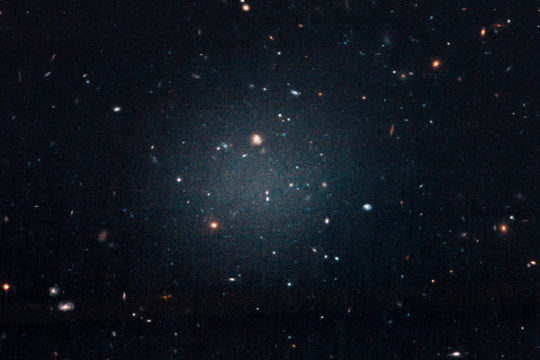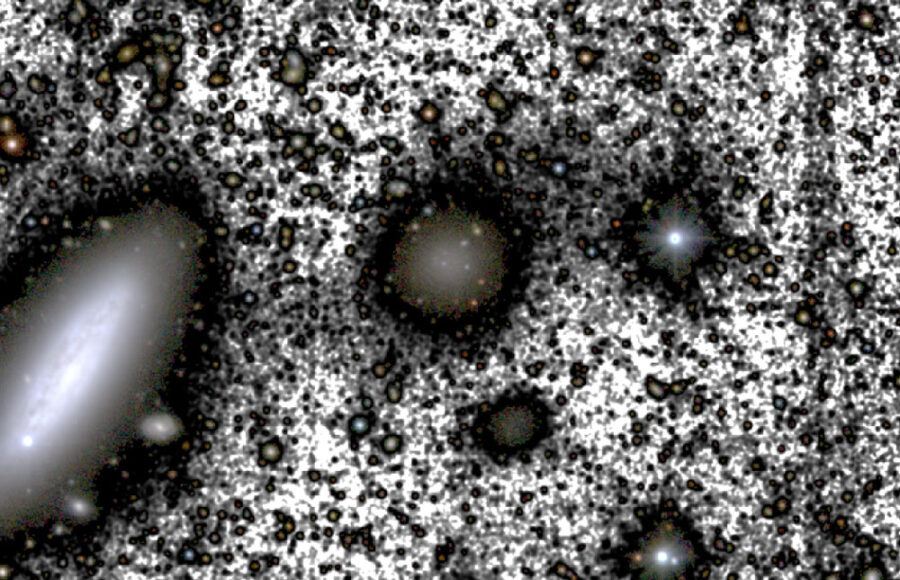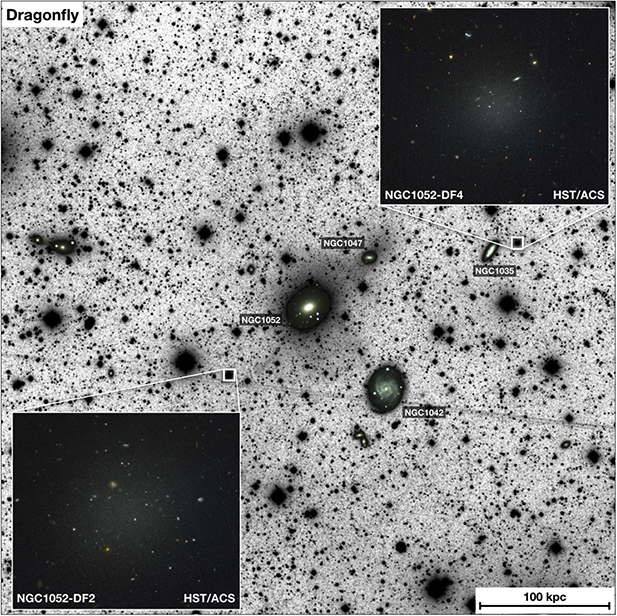An international team of astronomers has explained the lack of dark matter in a distant dwarf galaxy — another galaxy stole it.

NASA / ESA / P. van Dokkum (Yale University)
Two years ago, a deep image of the region around a bright football-shape galaxy known as NGC 1052 turned up something completely different: a fluffy dwarf galaxy that apparently lacked dark matter. Then, a year later, the same team of astronomers announced another dark matter-less galaxy in the same region.
The two, which go by NGC 1052-DF2 and -DF4, respectively, turned the idea of galaxy evolution on its head. Dark matter ought to be the galactic mold, creating the gravitational well that ordinary matter falls into to make galaxies. But if a galaxy is missing dark matter, how can it form in the first place?
The answer, Mireia Montes (University of New South Wales, Australia) and colleagues write in the December 1st Astrophysical Journal, is that the galaxies weren’t always missing dark matter. Looking more closely at DF4, they conclude that the gravitational pull of another nearby galaxy — spiral-shape NGC 1035 — stripped it away.
Going Deep
Using the Gran Telescopio Canarias and the IAC80 telescopes in Tenerife, Spain, as well as archival images from the Hubble Space Telescope, Montes’ team took a deep look at little DF4. These images reveal a faint S-shape to the galaxy’s outer limbs.

M. Montes et al. / Astrophysical Journal 2020
“It was quite a relief to see these kinds of distortions,” says Pieter van Dokkum (Yale), who was not involved in this study but led the team that discovered DF2 and DF4. The original images his team had taken hadn’t picked up any distortions and that had worried him, because without dark matter the galaxy ought to be flying apart. His team is now taking ultra-deep observations of their own. "We find qualitatively similar results," he says.
However, despite agreeing on the data, van Dokkum disagrees with the interpretation that another galaxy is pulling on DF4. The galaxy ought be ripped apart regardless whether it has a galactic neighbor, he explains, because it exists not in isolation but within a galaxy group. The combined gravitational fields of the entire group creates an environment such that a feeble galaxy like DF4 (or DF2, for that matter, or any galaxy without the stabilizing effect of dark matter) ought not to survive.
If NGC 1035 is doing the pulling, it would explain DF4's lack of dark matter. Like most molds, dark matter extends beyond the form of the galaxy. The Milky Way, for example, spans some 100,000 light-years, but its dark matter halo might extend 10 times farther out. So when two galaxies pass each other by, the larger one pulls on the smaller galaxy’s dark matter halo first, before it pulls any stars.
Montes and colleagues estimate from the extremely faint glow of the S-shape tails that 7% of the galaxy’s stars have flowed out into the tails already. That means that the dark matter has largely leaked away while the larger galaxy’s pull is only beginning to affect the stars.
Other tidally disrupted dwarf galaxies have been spotted in recent years that also lack dark matter, although those were more clearly galaxies in transition. The difficulty of seeing DF4’s tidal tails have made the answer in this case more elusive. This, Montes and her team argue, makes the study of faint details essential to understanding such distant, dim systems. (Montes' team did not include observations of the other galaxy, DF2, in this study.)
A Mystery Remains
However, while the galactic thief scenario explains the lack of dark matter, it doesn't address why these galaxies (DF4 and DF2 alike) have such lamp-like globular clusters, ancient balls of densely packed stars that orbit most galaxies.

P. van Dokkum (Yale University) / STScI / ACS
Van Dokkum’s team originally estimated the total mass of these puny galaxies by their globular clusters' orbits, and then compared that mass to the light they could see from the galaxies’ stars. They concluded that the galaxies were dark matter-less because the mass from both methods was the same — all the mass was in the stars.
The astounding conclusion of no dark matter obscured the other oddity: The fact that the globulars were so bright. Each one is as luminous as Omega Centauri, the very brightest globular cluster orbiting the Milky Way, and altogether they make up an unusually large percentage of the galaxies’ mass. (Montes and her team dispute this, as they measure a closer distance to both DF2 and DF4, which they say explains the globular clusters' odd properties.)
If a galaxy stole DF4’s dark matter, that would implies its evolution proceeded as normal until it ran into the galactic thief. But the globular clusters — if they are in fact exceptional — suggest otherwise. "Something must have happened to form these galaxies," van Dokkum says, "because tidal distortions don't explain the globular clusters."
The debate over these little dark matter-less galaxies is far from over.
Further Reading:
“A Galaxy Without (Much) Dark Matter”
“Globular Clusters Shine in a Galaxy Lacking Dark Matter”
“Why Are Two Ghost Galaxies Missing Dark Matter?”
Editorial note (Dec. 8, 2020): This post has been updated with additional information from Pieter van Dokkum (Yale) and Mireia Montes (University of New South Wales, Australia).
 3
3









Comments
Martian-Bachelor
December 9, 2020 at 5:22 pm
I really don't see this "S" shape they're talking about. Perhaps another picture with it drawn on by someone who knows where it is would help.
You must be logged in to post a comment.
Monica YoungPost Author
December 10, 2020 at 11:59 am
Indeed, it's pretty subtle! If you look at the close-up inverted color image, you'll see a very faint (black) shading to the top right of the galaxy and to the bottom left.
You must be logged in to post a comment.
Mike-Cavedon
April 10, 2021 at 10:03 am
Dark matter is the spacetime fabric. Dark matter is displaced by ordinary matter. Displaced dark matter is the physical manifestation of curved spacetime.
A galaxy's dark matter halo is displaced dark matter.
The reason for the mistaken notion the galaxy is missing dark matter is that the galaxy is so diffuse that it doesn't displace the dark matter outward and away from it to the degree that the dark matter is able to push back and cause the stars far away from the galactic center to speed up. The galaxy is too diffuse to displace the dark matter to such an extent that it causes the light to lense as it passes by the galaxy.
A galaxy's halo is not a clump of dark matter traveling with the galaxy. A galaxy's halo is displaced dark matter.
You must be logged in to post a comment.
You must be logged in to post a comment.